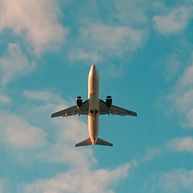
-
![plane between clouds]() Provided by: Philip Myrtorp/Unsplash
Provided by: Philip Myrtorp/Unsplash

Our travel guides are free to read and explore online. If you want to get your own copy, the full travel guide for this destination is available to you offline* to bring along anywhere or print for your trip.
*this will be downloaded as a PDF.Price
€4,95
Prince Naif bin Abdulaziz International Airport (ELQ)
The guide was updated:The Prince Naif bin Abdulaziz International Airport (ELQ), also known as the Al-Qassim Regional Airport or simply Gassim, serves flights to various destinations around the Arab world, including the Emirates, Bahrain, Egypt and Qatar, and even reaches as far as Istanbul. It is located about 30 kilometres west of the city of Buraidah and about 40 kilometres from Unaizah, and the best way to get to either city from the airport is to take a taxi, but be sure to agree on a price beforehand.
Useful Information
- Website: gaca.gov.sa/web/en-gb/page/home
- Phone: +966 16 380 0103
- Email: gaca-info@gaca.gov.sa
Digital Travel Guide Download
Our travel guides are free to read and explore online. If you want to get your own copy, the full travel guide for this destination is available to you offline* to bring along anywhere or print for your trip.
*this will be downloaded as a PDF.Price
€4,95

Saudi Arabia introduced a new eVisa system in October 2019, dramatically simplifying visa applications for citizens of multiple world countries, including the USA, Canada, China, Japan, Australia, and much of Europe. The new multiple-entry visa will be processed within record time (as quickly as 30 minutes), issued for one year, and will allow visitors to stay in the country for up to 90 days during its validity period. This marks a watershed moment in the country’s history, as Saudi Arabia has historically been off limits to non-Muslim tourists, with visas notoriously difficult to secure.
Citizens of countries not covered by the eVisa program will still need to turn to their nearest consulate to obtain a visa.
Read more

Prince Naif bin Abdulaziz International Airport (ELQ)
The Prince Naif bin Abdulaziz International Airport (ELQ), also known as the Al-Qassim Regional Airport or simply Gassim, serves flights to various destinations around the Arab world, including the Emirates, Bahrain, Egypt and Qatar, and even reaches as far as Istanbul. It is located about 30 kilometres west of the city of Buraidah and about 40 kilometres from Unaizah, and the best way to get to either city from the airport is to take a taxi, but be sure to agree on a price beforehand.
Read more

Cultural Norms
When strolling and exploring the city, please ensure you wear appropriate attire. Women must be covered from neck to toes, and in certain areas, scarves are used to cover the face and head. Shorts and tank tops should not be worn outside of private accommodation by women. For men, loose clothing is recommended, and shorts are prohibited.
When visiting, please make sure to respect and abide by the laws and culture of the country.
Read more

Postal Service
Saudi Post offices are usually open from Sunday to Thursday 8am–4pm, aligning with the standard workweek in Saudi Arabia. Some branches may also be open on Saturdays. Services typically include mailing and parcel delivery, financial transactions, and the sale of postal supplies.
Read more

Pharmacy
Common medications are readily available over the counter in most pharmacies, which are often located in malls, hospitals, and stand-alone shops. Prescription is needed for more potent medications. Adel Pharmacy is a well-known chain in Buraidah.
Read more

Telephone
Country code: +966
Al-Qassim area code: (0)16
Read more

Electricity
You'll find a variety of electrical sockets in Saudi Arabia, The most common are Type A (two flat parallel pins, commonly used in North and Central America) and Type G (three rectangular prongs in a triangular pattern, used in the UK). Type C, Known as the Europlug, can also be found. Saudi Arabia is one of the few countries in the world that use the dual-distribution voltage 127/220 volts at homes. Standard voltage 127 volts is used for household appliances and the 220 volts for high-load electrical appliances.
Read more


